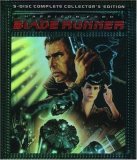| Reviews & Columns |
|
Reviews DVD TV on DVD Blu-ray 4K UHD International DVDs In Theaters Reviews by Studio Video Games Features Collector Series DVDs Easter Egg Database Interviews DVD Talk Radio Feature Articles Columns Anime Talk DVD Savant Horror DVDs The M.O.D. Squad Art House HD Talk Silent DVD
|
DVD Talk Forum |
|
|
| Resources |
|
DVD Price Search Customer Service #'s RCE Info Links |
|
Columns
|
|
|
Blade Runner
Blade Runner is perhaps the most tinkered with film in history. Based on Do Androids Dream of Electric Sheep? by Philip K. Dick, the movie has gone through a 25 year refining process in a story that could only happen in Hollywood. Ridley Scott had a grand vision for the picture, which was his follow-up to the blockbuster Alien. The
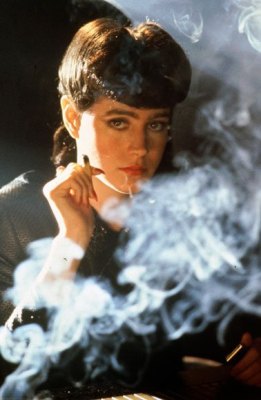 plot centered around Replicants, bio-mechanoid creations that mimic real humans in almost every way, except for a crippling lack of empathy. Harrison Ford played Rick Deckard, a cop who hunted Replicants, designated a Blade Runner. Almost from the start, troubles plagued the production, as the script went through several drastic rewrites, the budget kept escalating, and a well publicized feud between Ridley Scott and Harrison Ford developed. The end result was deemed commercially unacceptable by Warner Bros, who forced Ford to record a monotone narration that explained many of the concepts and plot points, and adding in a happy ending against Scott's wishes. Even with these changes (or perhaps because of them), Blade Runner was a flop when it was released in 1982. The success of E.T. in the same year proved that audiences of the day preferred to be told what to feel instead of being confronted about what they think.
plot centered around Replicants, bio-mechanoid creations that mimic real humans in almost every way, except for a crippling lack of empathy. Harrison Ford played Rick Deckard, a cop who hunted Replicants, designated a Blade Runner. Almost from the start, troubles plagued the production, as the script went through several drastic rewrites, the budget kept escalating, and a well publicized feud between Ridley Scott and Harrison Ford developed. The end result was deemed commercially unacceptable by Warner Bros, who forced Ford to record a monotone narration that explained many of the concepts and plot points, and adding in a happy ending against Scott's wishes. Even with these changes (or perhaps because of them), Blade Runner was a flop when it was released in 1982. The success of E.T. in the same year proved that audiences of the day preferred to be told what to feel instead of being confronted about what they think.The film quickly gained a new life on home video. Many people took inspiration from the movie's marvelously futuristic (yet shockingly retro) designs and the striking costumes. The picture endured, proving itself to be supremely influential on an entire generation of filmmakers. Roughly ten years after Blade Runner's initial theatrical release, a workprint was found that omitted both the narration and the happy ending, while containing other scenes not shown in the 1982 cut. The overwhelmingly positive public reaction to the screening of this print prompted Warner Bros. to commission a new cut, to be called the Director's Cut, which first ran to record numbers at the Nuart Theater in Los Angeles. However, proving that they still hadn't learned their lesson, WB didn't allow adequate time for Ridley Scott to prepare a cut, which left the job to a team of editors, working off of production notes. The Director's Cut nevertheless initiated an almost unanimous reappraisal of the film, with many of the movie's original detractors coming around to say how much better it now was.
But things never sat right with Ridley Scott, who ached to get a chance at making what he considered to be the definitive version of the film. The chances of this seemed slim as the movie slipped into a litigious rights battle that almost felt like it would never end. But finally, all the pieces fell into place and Scott personally oversaw a new cut, dubbed The Final Cut. This had a highly successful and oft-extended run at The Landmark in Los Angeles and the Zeigfeld in New York. Blade Runner's home video history is also quite convoluted. VHS tapes and laserdiscs of the Theatrical and '82 International Cut (almost entirely the same as the U.S. '82 cut, except for a few extra shots of violence) floated around for the years prior to the release of the Director's Cut. After 1992, those were pulled from circulation in favor of VHS tapes of the Director's Cut. The Criterion Collection re-released the International Cut on laserdisc to provide film fans with the first version of the film. Eventually both VHS and laserdisc were replaced by the now-ubiquitous DVD format. Despite the incredible surge of DVD sales, WB only ever released one poor quality edition of the Director's Cut. 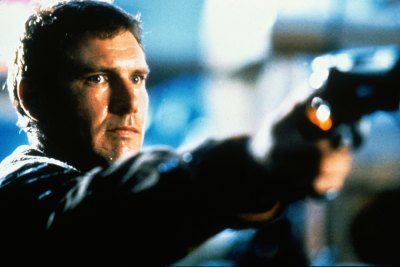 Recently, in preparation for the Final Cut, WB has released a remastered edition of the Director's Cut on a barebones DVD. But now, finally, Warner has done the film right, releasing a set that contains every cut of the film ('82 Theatrical, International, Director's Cut, Final Cut, and Workprint) on DVD, HD DVD, and Blu-ray.
Recently, in preparation for the Final Cut, WB has released a remastered edition of the Director's Cut on a barebones DVD. But now, finally, Warner has done the film right, releasing a set that contains every cut of the film ('82 Theatrical, International, Director's Cut, Final Cut, and Workprint) on DVD, HD DVD, and Blu-ray.
In all of its forms, Blade Runner takes place in Los Angeles in the year 2019. Most of the world's assets have been gobbled up by greedy multinational corporations, one of the largest being the Tyrell Corporation. Tyrell specializes in Replicants, exact duplicates of human beings that are used as slave labor. After an attempted revolt, Replicants were declared illegal on Earth, and special police units, known as Blade Runners, were formed to hunt them down. By 2019, the job is mostly finished, leaving Rick Deckard (Harrison Ford) in an unhappy retirement. But a group of Replicants, led by Roy Batty (Rutger Hauer), have made their way back to Earth, determined to make sense of their existence. Deckard is brought out of retirement for the sole purpose of killing each and every last one, a job made harder as Deckard begins to fall for Rachael (Sean Young), a Replicant of rare beauty and intelligence.
Blade Runner's influence on modern cinema is incalculable. The look, a mix of futuristic tech and classic noir, has become a touchstone for many production and graphic designers. There is a "Blade Runner look" and if one references it, everyone else will know what they mean. Ridley Scott's attention to detail has never been more apparent than it is here. Every conceivable item and logo that appears on the screen was meticulously created by the design team, from the magazines people read to the badges on the police uniforms. Even things you would never in a million years would see in the frame were made up and included, just to give an extra level of reality to the piece. The rank, oppressive atmosphere is enhanced by the sets, mostly constructed, which were eerily prescient of modern Tokyo, Hong Kong, and even parts of Los Angeles and New York. Scott correctly saw the melting pot of ethnicities and cultures that would occur in major cities.
On a technical level, the craft is impeccable. The opening shot, dubbed "the Hades Landscape" by the crew, is a visual marvel: a breathtaking cityscape, with miles of industrial waste vents, spewing flame and smoke, fills your vision. Having recently seen the Final Cut on the big screen with a sold out audience, the shot still brought audible gasps out of us (myself included). Jordan Cronenweth's cinematography was the best work he ever did, and he was highly regarded by his peers and enthusiasts alike. The contrast of light and shadow is astounding. Cronenweth wasn't afraid to let parts of the frame linger off to black, nor was he worried about having sources for all of his light. Thus we get these gorgeous shots where a beam of light will simply glide across the background of the scene, despite no obvious item in the frame creating that beam. And we never question it. Cronenweth took Ridley Scott's world of detail and turned it into a place with mystique and personality, and it's one of the most masterful pallets in all of cinema.
Perhaps the greatest achievement in Blade Runner is that even with all the visual spectacle, all the focus on the smallest physical details, the emotional backbone of the piece never got lost. In this film, Deckard is the antagonist. Roy Batty and his compatriots have returned to Earth in an attempt to discover a cure for their physical ailment - a four year life span. Their violence becomes understandable in this context. After all, birth is a bloody and violent process, and what is this quest but a search for rebirth? The audience 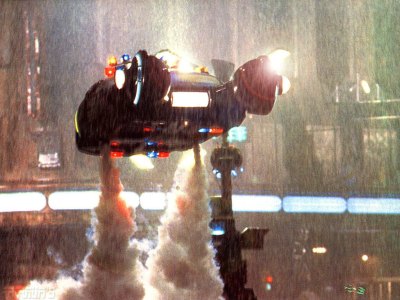 feels more for Batty and Pris than they do for Deckard, who is a bastard for most of the movie. Take the scene where he callously and cruelly tells Rachael that she is a Replicant, a fact that she barely even suspected prior to that point. Deckard's experiences hunting down the Replicants makes him remember his own lost humanity (one of the many reasons why it makes no sense for Deckard himself to be a Replicant, no matter what Ridley Scott says), but that doesn't make his hunt any more noble. When he kills Zhora, you can feel the pain of her ignoble death. All the characters, even minor ones like Gaff, have deep interior lives. Like the visual details, we may not see all of them, but intrinsically we know that they are there, and it adds more depth to the picture, which the audience can feel. While the visuals may draw us in, it's the emotional core that keeps us there and brings us back.
feels more for Batty and Pris than they do for Deckard, who is a bastard for most of the movie. Take the scene where he callously and cruelly tells Rachael that she is a Replicant, a fact that she barely even suspected prior to that point. Deckard's experiences hunting down the Replicants makes him remember his own lost humanity (one of the many reasons why it makes no sense for Deckard himself to be a Replicant, no matter what Ridley Scott says), but that doesn't make his hunt any more noble. When he kills Zhora, you can feel the pain of her ignoble death. All the characters, even minor ones like Gaff, have deep interior lives. Like the visual details, we may not see all of them, but intrinsically we know that they are there, and it adds more depth to the picture, which the audience can feel. While the visuals may draw us in, it's the emotional core that keeps us there and brings us back.
There are so many moments that jump out and stick in the memory. The opening shot is just the tip of the iceberg. Perhaps the most famous scene is the Roy Batty "Tears in Rain" sequence. This was originally planned to be a multi-page monologue. On the day of the shoot, Rutger Hauer distilled it down to its essence, delivering a simple and undeniably powerful speech that haunts the memories of anyone who hears it. If there's anything in the film that shows what it means to be human, that speech is it. Another infamous sequence is a scene where Deckard dreams of a unicorn, which Scott intended to use as a sign post to suggest that Deckard is a Replicant himself.
The Final Cut stands as the ultimate representation of Ridley Scott's vision. It's not terribly different from the previously released Director's Cut, as it has neither the narration nor the happy ending. It included the unicorn sequence, which is slightly longer. Some scenes have been shortened for pacing purposes. Shots from the Workprint have been added in, most notably the hockey mask dancing girls. Small snafus, such as wires attached to the Spinners, have been cleared away for this release. Larger mistakes have also been corrected. In all the previous versions (except the Workprint), Bryant gives an incorrect number of escaped Replicants, due to a scene written with a fifth Replicant that was never shot. That has been fixed, along with the obvious Joanna Cassidy stunt double. The sequence where Deckard questions Abdul Ben-Hassan has been fixed so the dialogue matches the lip movements. And the shot where the dove flies away from Batty has been completely redone to keep the visuals of the film consistent. Most of these changes are subtle, thankfully, not drawing attention to themselves or distracting the audience. The cumulative effect, however, is enormous. The world feels more immersive, the emotional impact more powerful. It took 25 years, but now we finally get Blade Runner the way Ridley Scott always wanted.
For a film about people with short life spans, Blade Runner is a remarkably long-lived piece of work. Certainly its influence has brought about a critical reappraisal, as well as the subsequent cuts that removed many of the more objectionable studio-mandated elements. But there are those who love the theatrical cuts more than the others, so it's not that simple. Blade Runner is incredibly complex, visually, emotionally, and thematically. People find more and more to discover with each viewing. It's this density, combined with a haunting lyricism, that gives the picture the staying power that it has. Blade Runner is a classic for the ages, a film that only gets better with age. Once you see it, you will never forget it. Thank you, Ridley, for letting us see what you saw with your eyes.
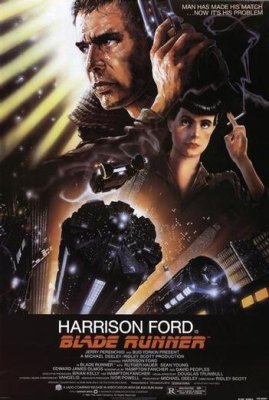
The Blu-ray Disc:
Warner Bros. has flooded the market with a bevy of Blade Runner home video releases. In preparation for this set, a barebones DVD of the remastered Director's Cut was released. Then, on Tuesday, December 18th, WB released several different editions on DVD, HD DVD, and Blu-ray. There's actually only one set available in the next-gen formats, a five-disc complete collector's set. This comes either as a set of five discs, or in a premium briefcase, with additional physical extras. Specifically, you get production drawings, a letter and drawing from Ridley Scott, a lenticular image, an origami unicorn and a miniature Spinner replica. The content on the discs is exactly the same.
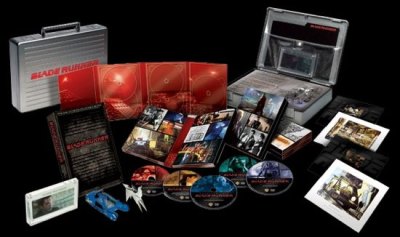
Note that the star ratings for this disc pertain to the Final Cut, as I am considering the other versions of the film to be archival, and thus supplementary features.
The Image:
Warner Bros. presents Blade Runner in its original aspect ratio of 2.40:1 in a VC-1 encoded 1080p transfer. What a difference a restoration makes. I've gotten so used to watching Blade Runner on VHS and eventually laserdisc (I only looked at the Director's Cut DVD a few times, preferring the International Cut on the Criterion laserdisc until this release) that this transfer is like seeing the movie for the first time. Jordan Cronenweth's remarkable cinematography is finally put on complete display. The interplay of light and dark is fully realized, with plenty of definition in the darkest scenes. And the level of detail Scott crammed in to the film can be seen, much of it for the first time. Text on newspapers, styles of clothing, the grains in the snake scale Deckard finds is all up there on the screen. You can seen the lines in Rutger Hauer's palm when he clenches his fist. Unbelievable. Color reproduction is rock steady, without so much as a single shade out of place. This disc is a testament to the visual capabilities of high definition. At no point did I think I was watching a 25-year old film. That's how good the Final Cut looks. If you've never seen the film before, you're in for a treat. And even if you have, I promise you will find something new to love here.
The Theatrical Cut, International Cut, and Director's Cut are all available on a single disc (disc three) in VC-1 encoded 1080p transfers. All three appear to be from the same transfer, and they generally look good. I noticed more grain and a slightly softer feel to these three than in the Final Cut, but they're unmistakably high definition. Anyone who prefers one of these cuts won't be disappointed. Interestingly, on the Blu-ray, you can select between the different versions via the pop-up menu. If you want to watch a scene in the International Cut and then see how it differs in the Director's Cut, you can pull up the Director's Cut, then go to its scene selections, and select the scene you like. What's really cool about this is that when you go back to the previous cut, it continues from the last place you left off. Very neat.
Ridley Scott mentions in an introduction to the Workprint that they took the last known print of that version and did what restoration work they could, but warns that it still looks very rough. He's not lying. The image, framed slightly differently at 2.20:1 and encoded at 1080p in VC-1, is very rough. It has much more grain than any of the other cuts. It's lacking in detail and the image often looks over saturated, with color balance skewed. Still, it is, as Ridley Scott points out, a work in progress, and was never meant to be viewed on a home video format, let alone one without the resolution of HD.
The Audio:
As is explained on one of the set's many supplemental features, the Final Cut went through an extensive sound restoration. Not all of the audio elements were in salvageable condition, and some have been lost completely. In those instances, new sounds had to be created, with the aim of making their integration as seamless as possible. If I had not seen that featurette, I would never have known they created new sounds at all, so I would say they reached their objective. The Final Cut gets a lossless Dolby True HD 5.1 mix that is a significant step up from any other version available (including the DVD release with only lossy Dolby Digital). The best beneficiary of the bump in aural resolution is Vangelis, who composed the film's score. Best known for Chariots of Fire, Vangelis created a truly unique electronic score that perfectly complemented Scott's world, and has also held up remarkably well. The True HD mix brings the music to life with rich and sumptuous tones. The resolution on the audio is excellent, with dialogue sounding especially crisp. The surrounds are used more for coloring than anything else, but they help sell the world with the ever-present rain. The only issue I had is a tendency to put echo on the character's voices a little too often. Other than that, this is by far the best Blade Runner has ever sounded.
The Theatrical, International, and Director's Cuts get Dolby Digital Plus 5.1 mixes. These did not undergo the same processes that the Final Cut did, so the audio is understandably more rough. The surround aspect is not nearly as seamless, and dialogue has noticeable hiss at times. But even these sound good compared to the Workprint, which, again, was culled from the best possible elements of a long out of use single print.
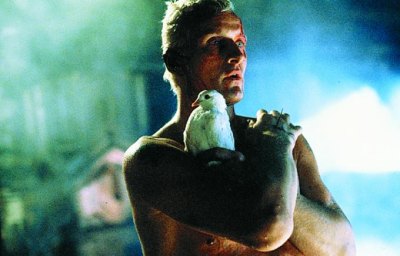
The Supplements:
Are you ready? As I mentioned before, this is a five disc set, and each disc either has supplements, or is a disc made up of supplements. None of the special features are in high definition, but with so much to go through, I'll give WB a pass on that one. I'll take things disc by disc.
Disc One: The Final Cut
- Introduction by Ridley Scott: Scott gives a short intro to this cut of the film, expressing his happiness at finally being able to have the film just as he wants it, and of course saying that it is his preferred cut.
- Commentary with Director Ridley Scott: Ridley Scott gives a frank and honest account of his thoughts on and feelings about Blade Runner. He talks about all kinds of things, from the development stages to techniques used on production, all the way up to the film's themes and the arduous process to the Final Cut. Scott is a very intelligent man, and he's consistently engaging in this fine commentary.
- Commentary with Writers Hampton Fancher and David Peoples, Producer Michael Deeley, and Production Executive Katherine Haber: The most disappointing of the commentaries, this one finds Fancher and Peoples commenting each other and Scott far more than they discuss the themes or content of the film. Most of their exchanges seem to be an attempt to give each other credit for the best lines. Deeley and Haber are heard much less, and their comments are more reflective, looking back on the film 25 years on.
- Commentary with Visual Futurist Syd Mead, Production Designer Lawrence G. Paull, Art Director David Snyder, and Special Photographic Effects Supervisors Douglas Trumbull, Richard Yuricich, and David Dryer: This commentary is obviously more technical in nature, but considering how influential the look and design of Blade Runner has become, this track is a goldmine of information. Almost every comment is another nugget of wisdom from legends in the field. If you're even halfway curious about how the filmmakers achieved the look they did, you have to hear this commentary.
Disc Two: Dangerous Days
- This is, in fact, one 3 and a half hour long documentary. It's split into eight sections (Incept Date - 1980: Screenwriting and Dealmaking, Blush Response: Assembling The Cast, A Good Start: Designing The Future, Eye of the Storm: Production Begins, Living In Fear: Tension on the Set, Beyond The Window: Visual Effects, In Need of Magic: Post-Production Problems, To Hades and Back: Release and Resurrection), but each flows into the other. It all starts with Hampton Fancher, who purchased the rights to Philip K. Dick's novella Do Androids Dream of Electric Sheep?. From there, the documentary takes you all the way through pre-production to the re-releases in various versions. Practically every major contributor to the film who is still alive gets ample screen time, including Ridley Scott, Michael Deeley, Hampton Fancher, David Peoples, Douglas Trumbull, Rutger Hauer, Sean Young, Joanna Cassidy, Daryl Hannah, Edward James Olmos, Joe Turkel, and Harrison Ford. They even get Ridley Scott's sons and Philip K. Dick's daughter to comment. The documentary is packed with exclusive and never before seen behind the scenes footage, along with outtakes, screen tests, and deleted scenes (including rather explicit footage of an extended take of Deckard and Rachael's love scene). There are also comments from filmmakers influenced by the picture, including Frank Darabont (easily the most entertaining person on the disc) and Guillermo Del Toro. If you ever wanted to know anything about Blade Runner, it's here.
Disc Three: Archival Versions
- Introductions by Ridley Scott: Ridley Scott introduces all three cuts available on this disc. He gives brief summaries of the differences, but never hesitates to mention his preference for the Final Cut.
- U.S. Theatrical Cut: As far as I know, this is the first time this version of the film has been available on home video, as the first VHS release of Blade Runner was actually the International Cut. This version has the studio-enforced narration and the happy ending. Considering it has less footage than the International Cut, this doesn't seem like it would be of much interest, but it's nice knowing it's here.
- International Cut: This was the version of the film available on VHS and laserdisc all the way up until the 1992 Director's Cut. Thus, this was the version that most people grew up with, and the one which started the original cult following. It's virtually identical to the U.S. cut, except it has a few seconds more of violence.
- Director's Cut: This was the 1992 cut Warner Bros. made after the extremely positive response from the screening of the Workprint. This was assembled by a team of editors, working off of Ridley Scott's notes. The biggest changes are the omission of the narration and happy ending, and the inclusion of the unicorn dream. This version has been completely supplanted by the Final Cut, and at this point is only of historical interest.
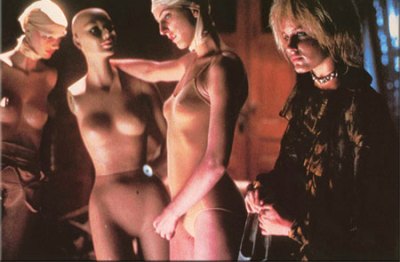
Disc Four: Enhancement Archive
- The Electric Dreamer - Remembering Philip K. Dick: Author Philip K. Dick's friends, relatives, and colleagues recollect the man and his work. Dick was an exceptionally gifted man whose drug use led to increasing paranoia and other mental hallucinations. Much of this is documented in his own work, especially in novels such as A Scanner Darkly and VALIS. This featurette, while short, does a good job of remembering the mad genius whose ideas lay at the heart of Blade Runner.
- Sacrifical Sheep - The Novel Vs. The Film: Dick's novel Do Androids Dream of Electric Sheep? is compared and contrasted against the film. Paul M. Sammon, Blade Runner expert and author of the thorough Future Noir: The Making of Blade Runner, gives a detailed summary of the differences between the two. Hampton Fancher and David Peoples explain many of the changes that they made when transferring the novel to the screen.
- Philip K. Dick - The Blade Runner Interviews: Paul M. Sammon spent quite a while interviewing Philip K. Dick (a particularly bizarre anecdote about Dick's seeming schizophrenia is presented in Future Noir in connection with these interviews) and several of his recorded interviews appear here. The interviews are consistently fascinating. Dick was a complex man, but his training as a writer shows here, as his use of language is wonderful. He talks at length about how pleased he is with Ridley Scott's production and how close it is to what he had in his head.
- Sign of the Times - Graphic Design: Remember all those details I mentioned earlier? The ones that barely even made it into the film? They get their turn in the spotlight in this featurette, with many design sketches and photos shown. Fans of classic Heavy Metal magazine (of which Ridley Scott was a huge admirer) should have a blast with this one.
- Fashion Forward - Wardrobe & Styling: Blade Runner's wardrobe aesthetic was heavily influenced by the film noirs of the 40's for the main characters, and then a multicultural hodgepodge of designs for people on the street. Deckard, Rachael, and Gaff's wardrobes are examined quite closely.
- Screen Tests - Rachael and Pris: Sean Young and Daryl Hannah weren't the only women who were considered for their respective roles, and here we get two screen tests with the other front runners. Neither are as good as the actresses who did get the parts, but it's still a fascinating look into the casting world.
- The Light That Burns - Remembering Jordan Cronenweth: Jordan Cronenweth was responsible for much of Blade Runner's atmosphere and aesthetic. He was a great artist, able to paint with light and color. But more than that, he was a genuinely gentle and generous human being. He's remember by friends, collaborators, and his son, Jeff Cronenweth, who has followed in his father's footsteps. You can tell the devotion these men still have for Jordan, as their voices often crack with emotion. There are some truly moving moments here. "Tears in rain" indeed.
- Deleted and Alternate Scenes: I can't believe this hasn't received more attention. There's almost an hour of new footage here, all pulled from the reams of film that the restoration team went through to make the Final Cut. These have been edited together to create a loose retelling of the story, all though unseen footage. This is all set to music from the film and Deckard's narration. But this isn't the narration from the theatrical cut, which was written quickly by an WB underling not connected to the film at all. This was from an earlier attempt at the narration by David Peoples, and it's amazingly different. The infamous Holden hospital footage is here, along with stuff I've never even heard of before. Did you know Deckard had a wife? I didn't. This is what I'm talking about. Even die hard fans of Blade Runner won't have heard about everything that's included here. And to think it's squirreled away among a selection of other extras. This is an unbelievable find and could be released on its own.
- 1982 Promotional Featurettes: A trio of vintage featurettes, these suffer from having a lot of clips from the movie itself, but there's also some really neat interviews with the cast and crew. These go a little deeper than your average on-set EPK, although they're clearly not as in-depth as Dangerous Days.
- Promoting Dystopia - Rendering the Poster Art: Artists John Alvin and Drew Struzan discuss the creation of the promotional images for the film.
- Deck-A-Rep - The True Nature of Rick Deckard: One of the big controversies Blade Runner has kicked up in its 25 years has been the question of whether or not Deckard is a Replicant. There were clues in the Theatrical Cuts that suggested Deckard might be a Replicant. At times, the Replicants' eyes glow orange in the film, as a visual cue to the audience. At one point, for just a few moments, Deckard's eyes exhibit a dull version of that glow. He also collects photographs, the same way Leon does. Once the Director's Cut was released, the debate blew wide open. Included was a scene where Deckard dreams of a unicorn, which gave new meaning to the scene at the end where Gaff leaves an origami unicorn outside Deckard's door at the end of the film. This featurette examines the controversy, with several different viewpoints offered. Ridley Scott says he always intended Deckard to be a Replicant, and "You'd have to be an idiot not to see it." Harrison Ford, on the other hand, is vehement in his contention that it makes no emotional sense for Deckard to be a Replicant. Frank Darabont gives a great argument for why the movie doesn't work if Deckard isn't human (an argument I completely agree with). Paul M. Sammon summed things up nicely by saying, "If someone asks me whether or not Deckard is a Replicant, I think the only truly correct answer I can give them is maybe."
- Nexus Generation - Fans and Filmmakers: As the title suggests, this featurette focuses on the filmmakers and fans that have been influenced by Blade Runner. Many are directors, who speak eloquently about the impact the movie had on them. Guillermo Del Toro admits that "All the rain in my films comes from Blade Runner" and Frank Darabont shows off some of his memorabilia.
- Trailers: We get one teaser, one theatrical trailer, and one TV spot from 1981/1982 for the original release of the film. Then a severely degraded trailer for the Director's Cut, a TV ad for Dangerous Days, and a really tacky ad for the Final Cut.
Disc Five: Workprint
- Introduction by Ridley Scott: Scott again introduces this version of the film. He makes apologies for the poor state of the elements, and points out a few of the differences in this version that never made it into any other version.
- Workprint: This is the cut that started it all. Run by accident at a 70mm film festival, this version caused such a stir that it prompted Warner Bros. to commission a brand new cut. As Ridley Scott points out, there are several differences here from any other version. The opening sequence is different, there are some shots missing, other shots that aren't in the other cuts, and no unicorn sequence.
- Commentary by Author Paul M. Sammon: Sammon, the world's leading expert on Blade Runner, gives an enthusiastic commentary on the workprint. This was recorded prior to the release of the Final Cut, and it seems the workprint was Sammon's favorite cut at the time of recording. He's quick to point out the differences from all the other versions, but doesn't limit his discussing to that subject. He talks about the films themes, gives anecdotes, and remembers his own visits to the set.
- All Our Variant Futures - From Workprint to Final Cut: A half-hour look at the restoration process used for the Final Cut. First came the image, then touch-ups to the special effects, including reshoots for Joanna Cassidy and Ben Ford, standing in for his father Harrison (don't worry, this footage has been integrated so seamlessly into the Final Cut that I couldn't catch it, even knowing it was there). Then the sound was cleaned up and remixed. Restoration Producer Charles de Lauzirika shows his extreme passion for the project, declaring Blade Runner his favorite film.
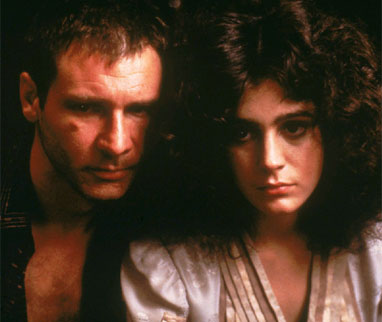
The Conclusion:
Blade Runner is, without a doubt, one of the most unique and influential films ever made. The Final Cut, created with Ridley Scott's input and approval, closes the last chapter on a saga that is as fascinating as the movie itself. This five-disc set collects everything required to tell the tale, including five versions of the picture, an exhaustive set of documentaries, and almost an hour of never before seen deleted and alternate takes. I can't think of a more complete set for any film in history. This collection is monumental, both for Blade Runner fans and proponents of film preservation. This is the most thorough and detailed set I've ever seen on home video, and given the high quality of the film, its stellar high def presentation, and the unbelievable set of extras, this set should be on the shelf of any self-respecting home theater owner. DVD Talk Collector Series.
Note: The images in this review are not representative of the image quality on the discs.
Daniel Hirshleifer is the High Definition Editor for DVD Talk.
|
| Popular Reviews |
| Sponsored Links |
|
|
| Sponsored Links |
|
|
| Release List | Reviews | Shop | Newsletter | Forum | DVD Giveaways | Blu-Ray | Advertise |
|
Copyright 2024 DVDTalk.com All Rights Reserved. Legal Info, Privacy Policy, Terms of Use,
Manage Preferences,
Your Privacy Choices | |||||||









